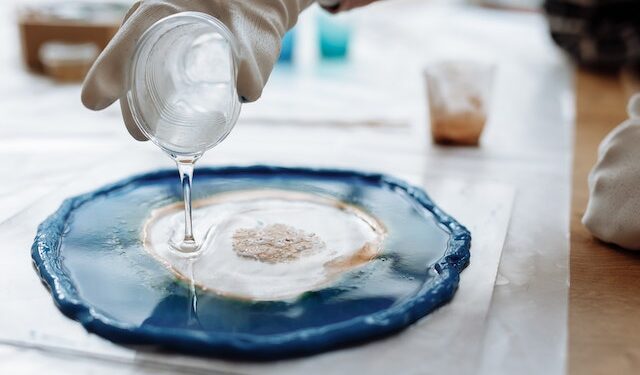Epoxy flooring is an economical and practical solution, making it the go-to choice for airport hangars and machine shops. Customizable to create unique colors, effects, textures and surfaces–such as making anti-slip surfaces using quartz sand to mix into the coating–epoxy flooring has many applications in commercial settings.
Static control epoxy floors provide essential protection for sensitive equipment from electrostatic discharge caused by regular foot traffic, making them suitable for workplaces where volatile chemicals and weapons are present.
Tough and Easy to Maintain
Anti Static Epoxy Coating are highly resistant, standing up to any spills and stains while being water- and bacteria-proof, making them perfect for kitchens, warehouses and hospitals. Furthermore, epoxy is one of the most cost-effective and easy-to-install flooring materials – an affordable alternative to rubber floor coverings!
An anti-static epoxy floor stands out from concrete by being customizable with vibrant colors and designs that add visual interest. Plus, its durable and easy maintenance make this material far superior than vinyl flooring that peels or fades over time!
Static electricity can cause havoc in many environments. It can damage electronics at technology-based companies or manufacturers, hospital equipment and even become explosive in locations handling combustibles. With anti-static epoxy floors, however, this issue can be avoided by adding special additives that ground the floor and conduct electricity away from its surface.
Anti-static floors provide another significant benefit, in that they can be seamlessly incorporated into a comprehensive ESD program, including ESD footwear, grounded table-tops and wrist straps to prevent static discharge on yourself or others.
Versatile and Customizable
Epoxy resin comes in an extensive array of colours, effects and styles that can suit the aesthetic needs of any space. This versatility means anti-static epoxy floors can be tailored for aesthetic purposes without compromising on quality or durability – they also withstand heavy loads without cracking! Epoxy flooring has become increasingly popular as a versatile alternative to PU flooring with similar characteristics but less customisation options available.
If your work involves sensitive electronics or flammable materials, static discharge could be a serious threat. Static electricity poses a severe fire hazard that can destroy electronic components while sparking fires within chemical containers containing volatile flammable chemicals. Standard epoxy floor coatings act as an insulator which encourage static build-up.
However, an ESD safe epoxy floor can mitigate this risk by dissipating electrical charges when someone walks across it – thus helping prevent electrostatic discharge build-up that puts employees and equipment at risk.
Before installing an epoxy floor, the surface must first be prepared. This means making sure it’s completely free of moisture and free from grease or oils to ensure proper adhesion between epoxy resin and floor surface.
Pouring some water on the floor to test for moisture content will show whether or not beads form, which indicates whether or not it can be coated without additional steps. If so, then your floor has reached the proper moisture levels and needs coating.
Easy to Clean
Epoxy floors stand out among other forms of industrial flooring as being particularly straightforward to keep clean, thanks to being seamless surfaces that lack cracks or gaps where dirt, grime, or chemicals can collect, making cleaning much simpler. Furthermore, due to being stain-resistant even tough chemicals won’t damage them in any way!
Antistatic epoxy floors are an ideal choice for many work environments where static electricity poses an inherent danger, or can even be fatal. This includes hazardous environments like those dealing with explosive materials that could ignite upon sparks from static discharge igniting fire or explosion; additionally they’re an excellent choice in facilities where explosive powders or liquids are handled.
When it comes to reducing static in your facility, antistatic/conductive/ESD epoxy flooring solutions may be your go-to choice. Particles of carbon graphite metal and metallic particles add conductivity while copper strips or tubing help provide grounding so stray static electricity can discharge safely without building up on personnel or sensitive equipment. Depending on the needs of your workplace, an antistatic epoxy floor may come equipped with additional ESD footwear or grounded table-tops as added measures of electrical safety.
Durable
Epoxy floor coating stands up against shocks, extreme temperatures and stains better than carpet, providing greater resistance than either. Furthermore, there are no seams or cracks where dirt accumulates or hides which allows bacteria to form in this surface material.
Selecting commercial flooring can be an intricate process with many considerations to take into account, including color, finish and texture. Yet sometimes less obvious features have an even greater influence over its performance and suitability for its intended use.
Industrial environments frequently necessitate anti-static resin flooring to avoid the buildup of static electricity that could discharge through feet onto electronics, electrical machinery and equipment causing costly damage or even fires. Without adequate anti-static protection such as this flooring option it would lead to costly damage or fire outbreak.
To prevent this from occurring, all occupants of a workplace will be required to wear special electro-static dissipative shoes that bridge the gap between themselves and surfaces in order to quickly discharge any charges that form within them and the surface; this helps ensure any build-up within bodies is quickly grounded away in order to protect people or equipment from injury.
To achieve this goal, an ESD floor coating must consist of both conductive and dissipative materials; its resistance value should range between 106 to 109 ohm per square. Furthermore, it must be laid on a substrate which is free from paint, lime, coatings, plaster and curing agents that could present contamination issues.









